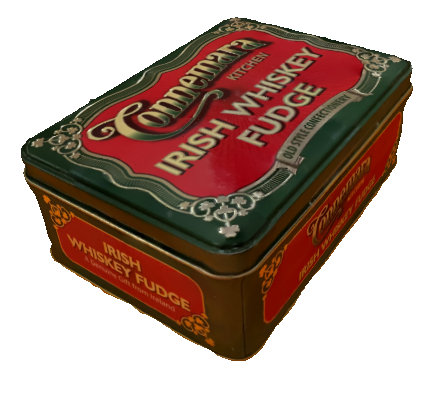Ada Hao
PAPRIKA
Collective
Nesting in Kilburn
![]()
Connemara Tin of Irish Coffee Fudge, bought at Belfast airport.
In memory of the life and work of th cartographer Tim Robinson and his wife Máiréad, who were Kilburn residents before they moved to Connemara.

Connemara Tin of Irish Coffee Fudge, bought at Belfast airport.
In memory of the life and work of th cartographer Tim Robinson and his wife Máiréad, who were Kilburn residents before they moved to Connemara.
Nestled within Kilburn's dynamic embrace is a way of living that intricately weaves the overlapping stories of migration across different communities and generations.
The focal point of this narrative is Kilburn High Road, or Watling Street as what it was called, a Roman road that transformed into a vibrant tapestry of cultural exchange. The conviviality, as eloquently described by the cultural sociologist Professor Paul Gilroy, emerges from the harmonious coexistence of diverse communities, creating a dynamic and ever-changing urban landscape. Looking through the lens of the community of Roman Catholic Augustinian canonesses, Kilburn was a stop on the way of pilgrimage to St. Albans in 13th century, the home to a therapeutic well in 17th century, a notorious duelling spot in 18th & 19th centuries, and an area that historically has been an attraction for local development.
One’s story could begin with the echoes of Windrush, marking the arrival of Caribbean migrants who brought the rhythm of calypso and the warmth of island culture. Their journey intertwines seamlessly with the Irish migration, fostering a unique blend of traditions where Irish pubs stand alongside Caribbean eateries. This cultural mosaic is a testament to Kilburn's nomadic spirit - a constant evolution that embraces change while preserving cultural roots. As the narrative unfolds, it extends to include the stories of new immigrants seeking refuge and opportunity. Kilburn transforms into a melting pot of languages, traditions, and dreams, reflecting London's ever-evolving cultural diversity. The nomadic sense of being comes to the forefront as the community adapts to ongoing changes, embodying resilience in the face of transformation. Professor Gilroy's concept of conviviality and the late British geographer and local Kilburn resident Professor Doreen Massey’s idea of interconnectedness both find their expression in the shared spaces along Kilburn High Road, where the nomadic spirit is palpable - a cultural dance of exchange and mutual respect.
©Ada Hao
The story encapsulates the collaborative efforts of community members-activists, artists, and businesses - working together to nurture a convivial atmosphere that transcends the challenges of urban life. My participation to the project of the Kilburn Museum Lab started with a walk in the Paddington Cemetery that is not too far from the Kilburn High Road.
Through conversation with Francesca, who also calls Kilburn home, we have a shared desire to understand Kilburn, its sense of space and place, its people, its character, and its links to spaces and places beyond. This “Kilburn Museum Lab” is a celebration of intertwined histories, emphasizing the ongoing transformation. It serves as a call to action, prompting reflection on what can be done collectively to contribute to the continuous improvement of Kilburn.
As we acknowledge the changes, the story challenges us to consider how we can actively participate in making Kilburn a better place for everyone, fostering a sense of belonging and unity amid diversity.
Ada Hao is the directorof PAPRIKA Collective, a
Kilburn-based non-profit
arts organization that acts
to expand the imaginings and futures of our sense of
people, place, and spaces
through the creative use of
the arts.
paprika.org.uk/
paprika.org.uk/